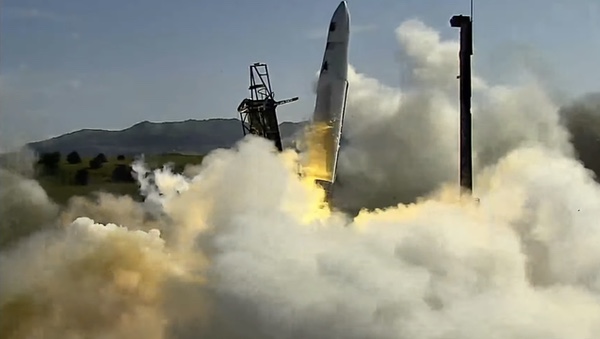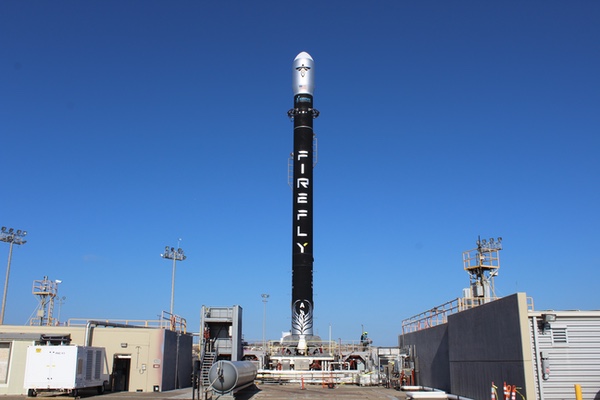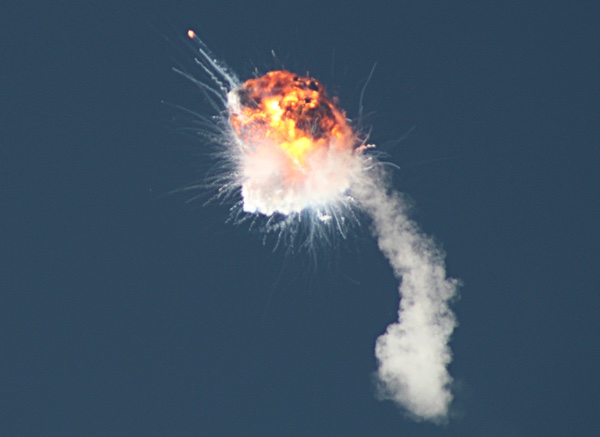Small launch vehicles face their biggest testby Jeff Foust
|
| Raising funding for launch startups is easier than ever. The obstacle launch startups now face is converting that funding into launch vehicles that can reach orbit. |
The launch industry has its own Great Filter. Hundreds of ventures have appeared over the last several decades, proposing to develop new launch vehicles that promise more frequent and more affordable access to space. Yet very few companies have successfully developed and operated commercial launchers, such as Orbital Sciences Corporation with the Pegasus three decades ago, SpaceX with the Falcon 1 and Falcon 9 a little more than a decade ago, and Rocket Lab and Virgin Orbit with their small launchers in the last few years.
For many years, the Great Filter of the launch industry appeared to be funding: without government support it was very difficult for startups to raise the large sums needed to develop a new rocket. The reusable launch vehicle startups of the latter half of the 1990s never got very far because of a lack of funding. A decade later, Rocketplane Kistler—itself a rebirth of Kistler Aerospace, which filed for Chapter 11 bankruptcy in the early 2000s—ran out of money in the 2008 financial crisis, despite a NASA commercial cargo award. Two years ago, small launch vehicle developer Vector closed its doors and liquidated its assets before its first orbital launch attempt.
But, like in astrobiology, the Great Filter is moving to the right. Raising funding for launch startups is easier than ever, and not just seed rounds to get companies started. Relativity Space, for example, has raised more than $1 billion in two rounds in the last year, even though it has yet to attempt its first orbital launch. Special-purpose acquisition corporations, or SPACs, have become a popular means for companies to go public and raise hundreds of millions of dollars, even if those companies have yet to generate any revenue.
The obstacle launch startups now face is converting that funding into launch vehicles that can reach orbit. Two ventures that suffered launch failures less than a week apart demonstrate that technical challenge may be a bigger factor sorting out the dozens of current startups from the handful likely to be successful.
 Astra’s Rocket 3.3 tips and begins to drift sideways seconds after liftoff August 28. (credit: Astra/NASASpaceFlight.com) |
Astra’s driftoff
Twice before, Astra tried to reach orbit and failed. In September 2020, a guidance system issue caused its Rocket 3.1 vehicle to drift off course shortly after liftoff from Kodiak Island, Alaska, triggering an engine shutdown. The vehicle fell back to Earth and exploded. Three months later, the company tried again with Rocket 3.2, which nearly reached orbit. The rocket’s upper-stage engine shut down seconds early when it ran out of fuel, causing it to fall just short of orbital velocity.
The company was confident that it could fix that problem with minor tweaks and declared it had demonstrated “orbital launch capability” despite not placing anything in orbit. “An identically performing launch from Cape Canaveral, for example, would have reached orbit at our target orbital velocity and target altitude,” Chris Kemp, CEO and co-founder of Astra, said in an earnings call last month. “Launching to polar orbits, like from Kodiak, Alaska, requires more performance than low-inclination orbits.”
| “Making any changes to a complex system like a rocket always involves risk,” Kemp said. “We appreciate this, but also believe that maximizing our learning requires us to make advances and take appropriate technical risks.” |
That earnings call was another sign of a changing company. Astra, which emerged from stealth mode in early 2020, announced a year later it was going public by merging with a SPAC called Holicity. The merger closed five months later, turning Astra into a publicly traded company on the Nasdaq and raising about $500 million to fund its growth plans, which include more powerful versions of its launch vehicles and a line of satellites optimized to launch on them.
Astra, now well-capitalized, still had to demonstrate it could place payloads in orbit. Its next launch was scheduled for August 27, carrying a test payload for the US Space Force. The payload itself would not separate from the upper stage but instead collect data on the launch environment to prepare for a second Space Force launch, then expected for later in the year under a deal announced in early August.
Astra did more than correct the fuel issue on the upper stage. The Rocket 3.3 vehicle that would launch that mission featured stretched propellant tanks in the first stage, reducing the mass of the upper stage, and consolidating more than a dozen unspecified components on the upper stage into a single unit.
“Making any changes to a complex system like a rocket always involves risk,” Kemp said in the earnings call. “We appreciate this, but also believe that maximizing our learning requires us to make advances and take appropriate technical risks.”
The first launch attempt of that rocket—designated LV0006 by Astra, a serial number whose leading zeroes quietly expressed its confidence in producing thousands of rockets to meet its goals of near-daily launches later this decade—was scrubbed August 27. The countdown went to zero and the engines ignited, only to immediately shut down. Astra later said engine thrust wasn’t ramping up as fast as expected at ignition, triggering the shutdown.
The next day the company tried again. At 6:35 pm EDT, the countdown hit zero, the engines ignited, and the rocket left the pad.
And then, almost immediately after leaving the pad, the launch went sideways—literally. The rocket tipped to one side, as if it was about the fall over and explode. Instead, it righted itself and started drifting to one side, hovering just off the ground, a maneuver some watching the live webcast—a first for Astra, which did not broadcast previous launches—called a “power slide” or “driftoff.” Only after about 15 to 20 seconds did the rocket stop going sideways and start to ascend.
By then, of course, the mission was doomed. The rocket continued to climb until about two and a half minutes after liftoff, when the range triggered a shutdown of the rocket’s first-stage engines because it was outside its licensed trajectory. After reaching a peak altitude of 50 kilometers, it fell into the ocean.
In a brief call with reporters an hour and a half after liftoff, Kemp said one of the five engines in the first stage shut down less than a second after liftoff, for reasons not yet known. “The guidance system was able to maintain control and the rocket began flying horizontally for a few seconds until we burned off enough propellants to begin resuming with our liftoff,” he said.
The issue, he added, was not linked to the aborted liftoff a day earlier. There was also speculation the rocket may have hit the launch mount as it lifted off, causing it to tip and go sideways, but Kemp said that if it did, it happened after the engine failure.
The company said it will work with the FAA, which licensed the launch, to investigate the failure and incorporate any changes into its next vehicle, LV0007. “We collected a tremendous amount of data from the flight, and we have Launch Vehicle 7 at the stage of production where we’ll be able to incorporate everything we learned before sending it up to Kodiak and launching again,” Kemp said.
 The Alpha launch vehicle on the pad at Vandenberg Space Force Base the day before launch. (credit: J. Foust) |
Firefly’s Alpha test
Five days later, it was Firefly Aerospace’s turn as it performed the inaugural launch of its Alpha rocket. In 2016, Firefly appeared to be the victim of the financial problems that had doomed other launch startups, running out of money and filing for bankruptcy. Ukrainian entrepreneur Max Polyakov bought the company’s assets and reconstituted the company, allowing it to continue work on Alpha. Firefly raised $75 million in May and has been working on a new, larger round.
| “Alpha is a pretty straightforward rocket design, so whatever problem we might have, we think it is something that can be addressed relatively quickly,” Markusic said before the rocket’s first launch. |
After years of development and delays—most recently waiting for a long-overdue delivery of a component of the rocket’s flight termination system from an unnamed vendor—Alpha was ready for launch. In an interview before the mission, Firefly CEO Tom Markusic was confident the vehicle was ready. “This vehicle has definitely been put through its paces,” he said, citing nearly 20 hotfire tests of its engines. “We’re ready to go.”
In the same interview, though, he acknowledged that first launches of new vehicle often fail. “It’s not unusual to have an anomaly on the first flight and then, just depending on the severity of the anomaly, it could be several weeks to several months” to correct the problem, he said. “Alpha is a pretty straightforward rocket design, so whatever problem we might have, we think it is something that can be addressed relatively quickly.”
A day before the flight, he and other company executives emphasized that point. “It’s a test flight,” said Lauren Lyons, a former SpaceX and Blue Origin engineer who joined Firefly in August as its chief operating officer. “Our really big goal is to get Alpha to space. If we can get to orbit, even better. If we can open up that fairing and deploy those satellites, even better. Our goals are to collect as much data as we possibly can and take Alpha as far as it can go.”
Alpha is designed to place up to a metric ton into low Earth orbit, but on this mission, called Dedicated Research and Educational Accelerator Mission (DREAM), it was carrying less than 100 kilograms: a collection of cubesats, technology demonstrators, and what the company called “non-technical” payloads, which ranged from photos to memorabilia.
Alpha would also fly an unusual trajectory, heading west and not south from the former Delta II launch pad at Vandenberg Space Force Base. If the payloads made it to orbit, they would go into a retrograde orbit at a relatively low altitude of 300 kilometers.
That move, Markusic said, made range safety easier. “If we were flying due south, we’d have a very tight corridor we’d have to go down though,” he said the day before the launch. “Here, we have a very wide corridor so that, if the vehicle’s not tracking quite right, it gives us an opportunity to get back on track without having to terminate the mission.”
Firefly had a four-hour launch window at Vandenberg on September 2 that opened at 6 pm local (9 pm EDT). An initial launch attempt was halted in the final seconds of the countdown for unspecified issues, but controllers recycled the count and tried again 59 minutes later. This time, the count reached zero, the engines ignited, and Alpha took off from the pad.
It looked at first like the launch was going to plan. The vehicle climbed and appeared to be stable. The only indication of a problem was when a controller said more than 90 seconds after liftoff that the vehicle was not yet supersonic. According to a mission timeline released by the company, Alpha was supposed to hit Mach 1 67 second after liftoff, and maximum dynamic pressure, or Max Q, nine second after that. Something was causing the vehicle to underperform.
Finally, 2 minutes and 20 seconds after liftoff, controllers announced the vehicle was now supersonic. Seconds later, though, it started to tumble. Video showed that, in the first gyrations, the rocket’s payload fairing was ripped off. The rocket, though, remained intact as it tumbled for about ten seconds. Then, an explosion destroyed the vehicle, which Firefly said was the result of the range triggering the rocket’s flight termination system.
Firefly released Sunday a video of the launch along with an initial explanation of what happened. One of the four Reaver engines in the first stage of the rocket shut down 15 seconds after liftoff. “It was an uneventful shutdown—the engine didn’t fail—the propellant main valves on the engine simply closed and thrust terminated from engine 2,” the company stated, but didn’t explain why the valves closed.
| “Although the vehicle did not make it to orbit, the day marked a major advancement for the Firefly team, as we demonstrated that we ‘arrived’ as a company capable of building and launching rockets,” it stated. |
With three engines, the rocket could continue to ascend, but more slowly, which would explain why the announcement that the vehicle was supersonic came a minute late. Going transonic was too much for the vehicle’s to take. At that point, Firefly stated, “thrust vector control was insufficient and the vehicle tumbled out of control.” The range then activated the flight termination system to destroy the rocket.
“Firefly has commenced a thorough anomaly investigation to gain understanding of why engine 2 shutdown early, and uncover any other relevant unexpected events during flight,” the company said, working with the FAA and Space Launch Delta 30, which operates the range at Vandenberg.
How long the investigation and subsequent corrective actions will take remains to be seen. Markusic said before the flight that, had the first launch gone well, the company would be ready for a second launch, this time with a commercial payload, as soon as December.
In its Sunday announcement, the company emphasized the launch, while a failure, was a step forward. “Although the vehicle did not make it to orbit, the day marked a major advancement for the Firefly team, as we demonstrated that we ‘arrived’ as a company capable of building and launching rockets,” it stated. “We also acquired a wealth of flight data that will greatly enhance the likelihood of Alpha achieving orbit during its second flight. In short, we had a very successful first flight.”
Real success, though, will come when Astra, Firefly, and other small launch vehicle developers demonstrate they can place payloads into orbit. At that point they will have passed one filter, from funding to launching. As more companies follow, though, we may find the industry’s Great Filter is further to the right: not just raising money or building rockets, but instead developing a sustainable business. That may be the biggest challenge of all.
Note: we are using a new commenting system, which may require you to create a new account.
